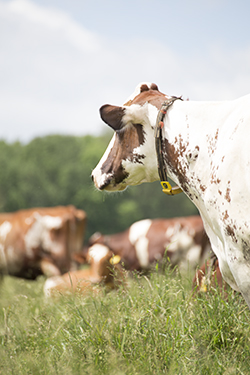
Since the early 2000s, automated heat detection has played an important role in reducing breeding and associated labor costs by eliminating the need for reproductive synchronization protocols. Farmers revealed they were happy with the systems, giving them a 94 percent satisfaction rating, reported by a survey of 219 German dairies that implemented automated detection methods.
My home farm implemented the technology in 2012 after years of breeding based on timed artificial insemination (TAI) and visual observation. Our goal was to drop calving intervals by getting more cows pregnant earlier in lactation. We continued using some heat synchronization along with the activity monitors and have been fairly happy with their success. However, we also learned that there is still an important human element to getting cows safe in calf. There will still be the occasional false heat recorded by activity monitors, and we still have to walk out to the barn at the correct time to breed the cow if we expect them to be pregnant.
About the time we began looking at monitors, Kansas State University began a trial on their dairy using them. The results from that trial and the subsequent experiments were recently published in the Journal of Dairy Science. The studies revealed that more cows became pregnant earlier in lactation using activity monitors than using a timed A.I. program. However, the conception risk, formally referred to as conception rate, of activity monitor-assisted breeding was similar or less than that achieved by timed A.I.
They also found that producers have an even smaller window of time to breed cows for the best results. Their studies indicated that the optimal time to breed first-lactation cows was 13 to 16 hours after peak activity, while the optimal time to breed second- and greater-lactation cows was within the first 12 hours. Additionally, the research showed that cows producing more than 99 pounds of milk per day reached optimal breeding time 2.4 to 4 hours earlier than cows producing less than 99 pounds of milk.
The studies have no doubt revealed that if we expected our automated heat detection to reduce the amount of work we put into getting cows bred, we were wrong. Even with the best technology, a good breeding program requires attentiveness and good management.
 The author is the 26th Hoard's Dairyman editorial intern. This fall she will be a senior at Kansas State University in Manhattan, Kan. At KSU, Maggie is double majoring in agricultural communications and journalism and animal sciences and industry. Seiler grew up on a 130-cow registered Holstein dairy in Valley Center, Kan., near Wichita.
The author is the 26th Hoard's Dairyman editorial intern. This fall she will be a senior at Kansas State University in Manhattan, Kan. At KSU, Maggie is double majoring in agricultural communications and journalism and animal sciences and industry. Seiler grew up on a 130-cow registered Holstein dairy in Valley Center, Kan., near Wichita.







